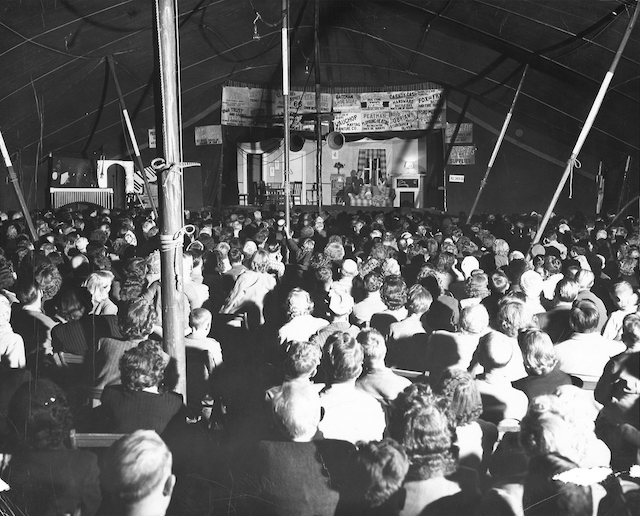
The Schaffner Players perform in 1949’s “How Funny Are People” in Centerville. Photos courtesy of the Theatre Museum of Repertoire Americana in Mount Pleasant
Sept/Oct 2022 (Volume 14, Issue 5)
By John Busbee
With 1851 origins (another source claims that a tent was used for public performances in 1825), tent shows reigned supreme for almost a century before technology dethroned these undeniable early rulers of public diversion. Public tastes grew, and the variety of traveling shows was diverse. The golden age of tent shows was in the 1920s with some 400 companies touring. Tens of millions gathered under these nomadic emporiums of entertainment, marveling at global wonders, entertainment, education and much more. Their decline reflected the emergence of new technologies — moving pictures, radio and television. Rare 21st century tent shows, more nostalgic indulgences than entertainment resurrection, reflect their bygone glory. When these happen, audiences still come, like laugh-starved moths to the entertainment flame.
Repertory theatre shows were special
Tent shows came in a variety of formats. Perhaps the most exotic and spectacular were the circuses. “Circuses were based on the idea that rural townsfolk were underexposed to the world, and the circus was the medium through which they could experience exotic entertainment and ideas,” proclaimed the “Traveling Medicine Show.” The Ringling Brothers, born in McGregor, anchored Iowa’s circus contributions.
Medicine shows evolved from the circus format and were groups of traveling performers. Featuring entertaining acts, their performances were “interspersed with sales pitches peddling miracle cures, elixirs and other products of a dubious nature,” according to “Traveling Medicine Show.”
Vaudeville’s roots are in tent theatre, establishing itself after the American Civil War with its variety show format. Vaudeville presented a range of entertainment styles, with no need for a connecting theme. Vaudeville became a mainstay in performance halls across the U.S., and many of its stars successfully transitioned into television and cinema — Charlie Chaplin, Mae West, Sammy Davis Jr., Fred Astaire, even Iowa’s own William Frawley (Fred Mertz in the “I Love Lucy” show).
Wild West Shows held a unique place. One of the best known was Iowa native Buffalo Bill’s Wild West. William F. “Buffalo Bill” Cody was born in Le Claire. His show toured extensively in Iowa, performing 164 shows in 50 Iowa towns between 1874 and 1915, according to the Buffalo Bill Museum & Grave in Golden, Colo. These shows were based on “The American West,” perpetuating the western mythology of the cowboy, while exploiting Native Americans, many of whom were part of the troupes. Reenactments of “cowboys and Indians” encounters were centerstage, and other elements included sharpshooting demonstrations and animal exhibitions.
Chautauqua tent shows distanced themselves from the extravaganza and flair of the other styles.
“Although Chautauqua programs were performed in a tent, on a stage, by professional entertainers, for which admission was charged, extreme care was taken to keep this separate from ‘show business,’” according to William Slout’s book “Theatre in a Tent, the Development of a Provincial Entertainment.
Eschewing the showiness of other tent theatre styles, audiences found the Chautauqua’s educational appeal no less entertaining. People flocked to Chautauquas.
“Oldtimers will remember the Chautauqua for its oratory, music, drama, bell-ringers, lecturers, cooking schools, crusaders and evangelists. Chautauqua derived its name from meetings held on the shore of Lake Chautauqua in New York,” according to the The Palimpsest (Vol. 47, No. 8).
Repertory theatre tent shows were special celebratory occasions when they came to town. The term repertory shifted to repertoire, which was colloquialized to “rep.” These shows resembled the touring theatrical productions known today. With rep, a variety of shows is presented during its run, inside its mobile performing hall: their dominating canvas tent. The variety of shows may include a moral play, fancy dress and rustic dramas, period play and a family comedy. Neil Schaffner always ended each stay with a farce — “leave ’em laughing” was his motto. Depending on the size of the town, a rep theatre may stay just a night or two, or a week, or longer.
Iowa is a cornerstone contributor to rep theatre, boasting one of its strongest historical threads. From “Yankee” Robinson, to J.S. Angell, to Neil and Caroline Schaffner, to Jimmy Davis, this cultural chain holds more than 170 years of history. Mentioning tent theatre is synonymous with two of its best-known characters, “Toby” and “Susie.”
The Theatre Museum of Repertoire Americana in Mount Pleasant is the nostalgic bastion of bygone performance arts, housing a bounty of archives, relics and more. Toby and Susie are infused in this edifice, as Neil and Caroline Schaffner’s extensive personal collection are there. Neil and Caroline were perhaps the most celebrated performers to portray Toby and Susie. A Midwest Old Settlers and Threshers Association signature museum, the National Society for the Preservation of Tent, Folk and Repertoire Theatre was founded to help administer and maintain the Theatre Museum of Repertoire Americana. Its purpose is “to preserve and perpetuate for educational and historical insight, the heritage, the memorabilia and the culture of tent folk and repertoire theatre and to provide a place for literary endeavors and scholarly research.”
TO READ THE ENTIRE STORY AND OTHER FASCINATING STORIES ABOUT IOWA HISTORY, subscribe to Iowa History Journal.
